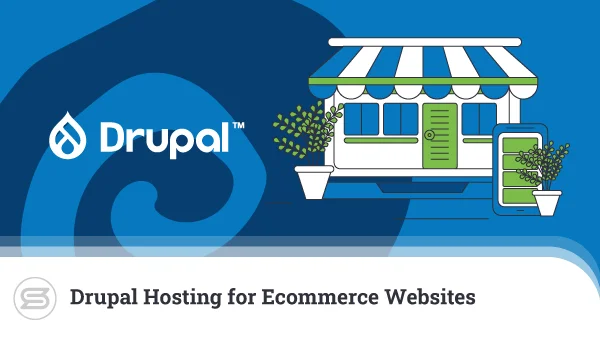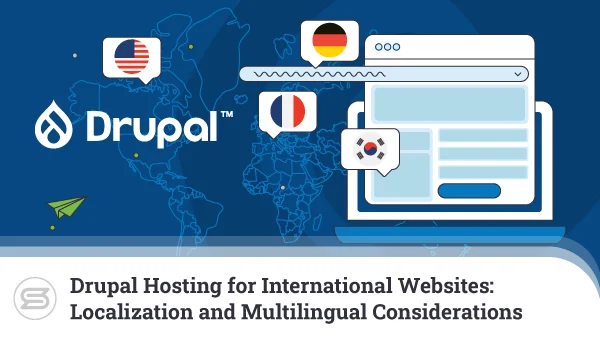Drupal Multisite Hosting: Pros, Cons, and Best Practices
Drupal is universally acknowledged as one of the most versatile platforms of its kind. Funnily enough, this versatility is exactly what sometimes drives people away.
Faced with an enormous array of tools and features, some users think that Drupal is too complicated and tricky to get used to.
It is true that some of the underlying functionalities require research and time to get right. However, if you look closer into the Drupal ecosystem, you’ll see that the open-source community has produced enough resources to help you familiarize yourself even with the less popular features. When you begin using them, you’ll realize that the time you invested in getting to know the platform is well spent.
Today, we’ll prove this by introducing you to Drupal Multisite hosting and showing you how to make the most of it.
Introduction to Drupal Multisite
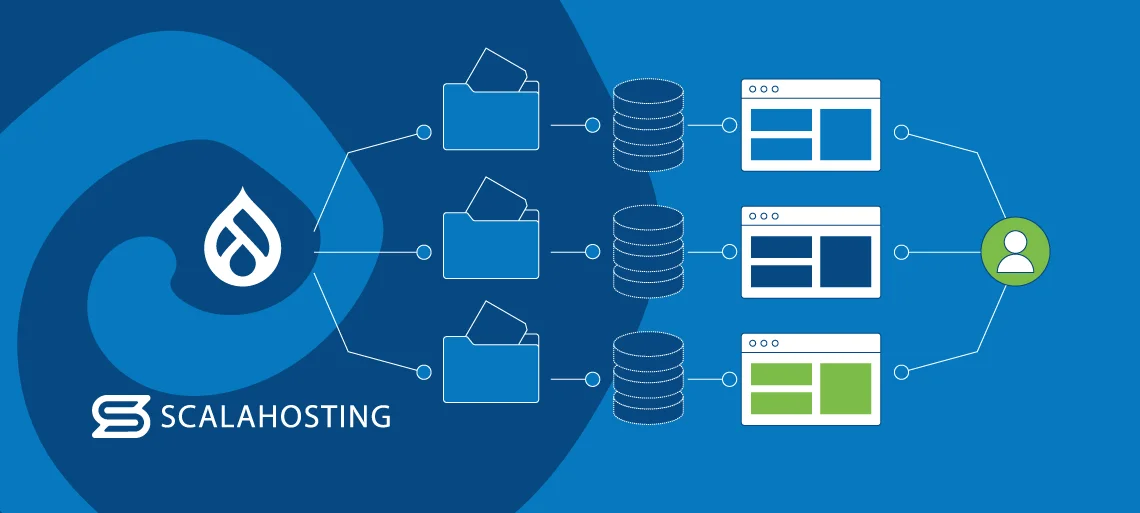
Those of you with more experience in the web development business may have heard about WordPress multisite. In certain aspects, Drupal Multisite is pretty similar.
In essence, this feature allows you to host multiple websites under the same Drupal installation. Instead of setting up a separate Drupal instance for every new project, you have a single core supporting all your sites.
But how does it work behind the scenes?
You have a Drupal installation with multiple domains pointed to it. Depending on your preferences, your websites can either share the same database or use their own. Your websites can also have their individual theme and set of modules.
Each site in the Multisite setup has a subfolder containing its configuration files and add-ons. When a user tries to access one of the websites, the Drupal core figures out what content it needs to serve and delivers it.
Crucially, the projects hosted under the multisite installation appear completely independent to the outside world.
Of course, this isn’t the only way to run multiple Drupal websites in the same place.
In fact, some would even say that setting up individual Drupal installations and managing them separately is easier. Indeed, thanks to modern control panels and auto-installers, doing it is hardly rocket science.
So, is there a point to using Drupal Multisite at all?
Pros and Cons of Using Drupal Multisite

The Multisite feature has been a part of the Drupal CMS for years now, and although some users aren’t particularly fond of it, the fact it’s still around shows that it does have its advantages. Let’s explore some of the main ones.
Pros
- Cost-efficiency
A typical Drupal installation requires around 80MB. Without Multisite, you’d need a new installation for every website you create. With it, you only need one. Indeed, storage space is hardly the most expensive hardware resource nowadays, but over time, the savings will rack up, especially if your business has a significant number of websites.
- Easier updates
We all know how important updates are. Every new Drupal version comes with tons of security and stability improvements that could be crucial for your project’s future. The thing is, installing updates isn’t always as straightforward as you think. Every time a new Drupal version comes out, you have to create a backup before applying the update, hoping nothing goes wrong. Without Multisite, you’d have to do this for every single website. With it, you have only one codebase, so you only deal with a single backup.
- User management
If you run all your websites on top of a single database, you can allow users to register one account and use it everywhere. This not only provides the convenience of managing everyone’s accounts from the same place but also improves the user experience.
- Better control
As a Multisite administrator, you can see what everyone is doing on your websites more easily. Having a single Drupal core means there are fewer things to look at and fewer logs to review if things go wrong, allowing you to quickly resolve issues.
- Easier growth management
Although it may seem a bit complicated at first, launching a new project in a Drupal Multisite installation is fairly straightforward. It’s certainly faster than setting up a new Drupal core and building on top of it. This becomes important as your business expands, and you need to launch new websites with as little hassle as possible.
So, there are quite a few pros to using Drupal Multisite. However, this doesn’t mean the setup is perfect for every business with multiple Drupal websites. The Multisite feature does have a few limitations that must be considered before you start work on your first project.
Cons
- Limited flexibility
The individual projects running on a single Multisite installation can have their own themes and modules, but this doesn’t mean you get unlimited freedom when developing them. They all use the same codebase, so if you want to enable a specific feature, you may need to have web developers delve deep inside the Drupal core. If something’s not quite right after the modifications they make, the problems are likely to affect all websites on the Multisite setup.
- Complex management
You may enjoy the convenience of managing all your sites from a single codebase, but if you want to efficiently manage all the projects at once, you have to be on your toes and fully aware of what goes where. Certain tasks, like installing custom plugins, for example, could be more complicated than they would be if the websites were hosted separately.
- Tricky migration
Usually, nothing is irreversible in the world of web development. Still, if you build a Multisite setup and decide to separate one of the websites to run in its own environment, you could face issues. The Multisite feature is not designed to let you easily migrate single projects from one place to another, and the task could be even trickier if all your sites use the same database.
Keep in mind that site migrations should not be an issue that concerns you. Teaming up with a knowledgeable provider like ScalaHosting will not only pair you up with expert Drupal support, but we will take care of any site migrations you may need – completely free of charge.
- Security concerns
The codebase that supports all your websites effectively becomes a single point of failure for all of them. If something goes wrong with it, all your projects go down. This means that if hackers want to harm your online business somehow, they can do it with much less effort. If you want to use Drupal Multisite, it’s good to bear in mind that you’re a bit more susceptible to getting attacked than you normally would be.
- Dependencies
With Drupal Multisite, multiple websites work in the same environment. The lack of any form of isolation means they could interfere with each other. For example, a bug in a module used by one of your sites could affect the rest. This means that whenever you want to install a plugin you haven’t used in the past, you’ll want to test it and ensure it doesn’t cause any problems. All that hassle could offset the convenience of having everything in one place.
Drupal Multisite Use Cases and Best Practices
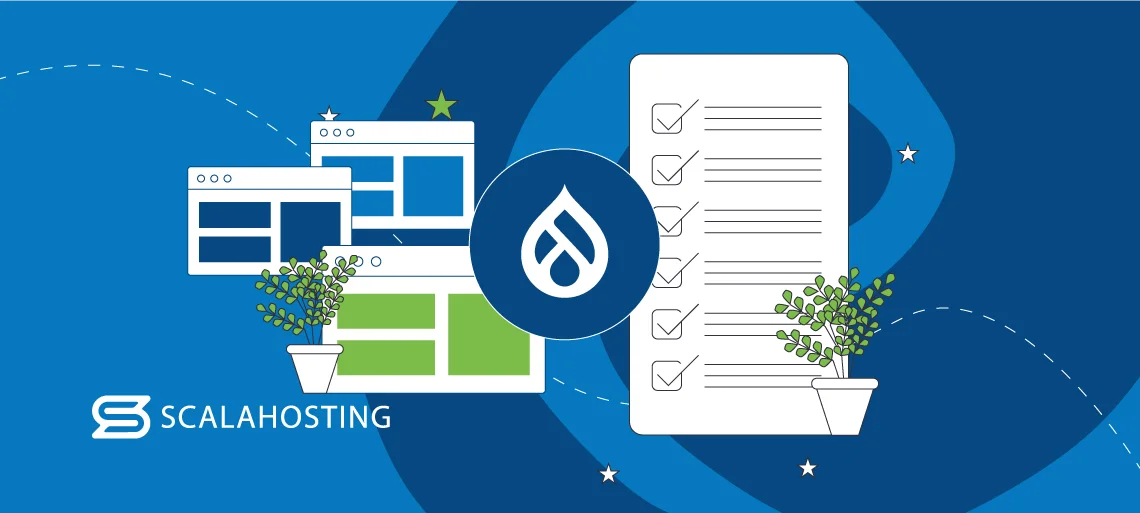
It’s clear that Drupal Multisite isn’t a one-size-fits-all solution for organizations that need to build multiple websites.
So, how do you know if Drupal Multisite is suitable for your particular business?
The most important thing to consider is the nature of the websites you’re going to build. Indeed, Drupal Multisite allows you to run two projects with a completely different set of modules under the same installation. However, the customization options are not unlimited.
For example, if you’re a development agency building websites for different clients with different requirements, the Multisite feature would be an inconvenience. In addition to the difficulty of efficiently creating completely unrelated projects, you’ll also have issues if clients decide to move to a different developer or server.
A Drupal Multisite setup may work if you need to build a combination of sites, like a main website and a blog, for example, but whether it will be the most convenient option depends on a number of different factors. Ultimately, you need to consider how you’ll build the websites before deciding whether or not Multisite is for you.
There are a few scenarios where this Drupal feature can be extremely useful, though. Let’s take a look at some of them:
- Ecommerce businesses running multiple online stores
You can turn Drupal into a fully-featured ecommerce platform with the help of a couple of modules. And if you need to set up a network of online stores, the Drupal Multisite feature may be the one for you. Your individual sites may belong to different departments, or you could set up stores for clients from various geographical regions.
- News outlets and publishing networks
Media companies tend to operate multiple websites, blogs, and publications. Managing content creation and distribution across all of them could be a challenge. The correct Drupal Multisite setup can streamline the process immensely.
- Schools, colleges, and universities
Educational institutions can use Drupal Multisite to build and run individual websites for their departments, faculties, campuses, etc. The unified platform helps them distribute academic resources more efficiently and boosts student engagement.
- Medium-sized and large corporations
Corporations have multiple departments and often operate in different geographical regions. They are rarely served by a single website only, so there may be an entire network of pages you need to manage at once. If there’s a dedicated team taking care of all sites, you can most likely optimize the process with the help of Drupal Multisite.
Setting Up a Drupal Multisite Installation
Drupal’s Multisite feature doesn’t have any special requirements. To efficiently run several projects on a single Drupal codebase, you need a web server (like Apache or Nginx), a database engine, a PHP interpreter, and access to the server via FTP or SSH.
Some of these features may not be available on a shared hosting account, but this doesn’t concern you too much, as you shouldn’t be using a shared plan anyway.
Even if the package allows you to host multiple domains, a shared account can’t provide the performance you need to support several Drupal sites simultaneously, regardless of whether they’re on a Multisite setup.
What you need is a managed VPS solution. This type of hosting service offers guaranteed resources and an isolated environment, giving you consistent performance, bulletproof security, and practically unlimited scalability.
A managed virtual server also comes with a control panel and a few additional tools that simplify the process of configuring your very own Drupal Multisite installation. Let’s have a look at the steps.
- Set up a hosting account with the primary domain name.
When you create your new hosting account, your host will ask you for a primary domain name. The name should be pointed to the public_html folder inside your account, where you’ll host your main website.
- Install Drupal.
Your hosting account’s control panel likely has an auto-installer like Softaculous, so setting up Drupal should be a two-minute job. Make sure you install it in the document root folder of your primary domain name (i.e., public_html).
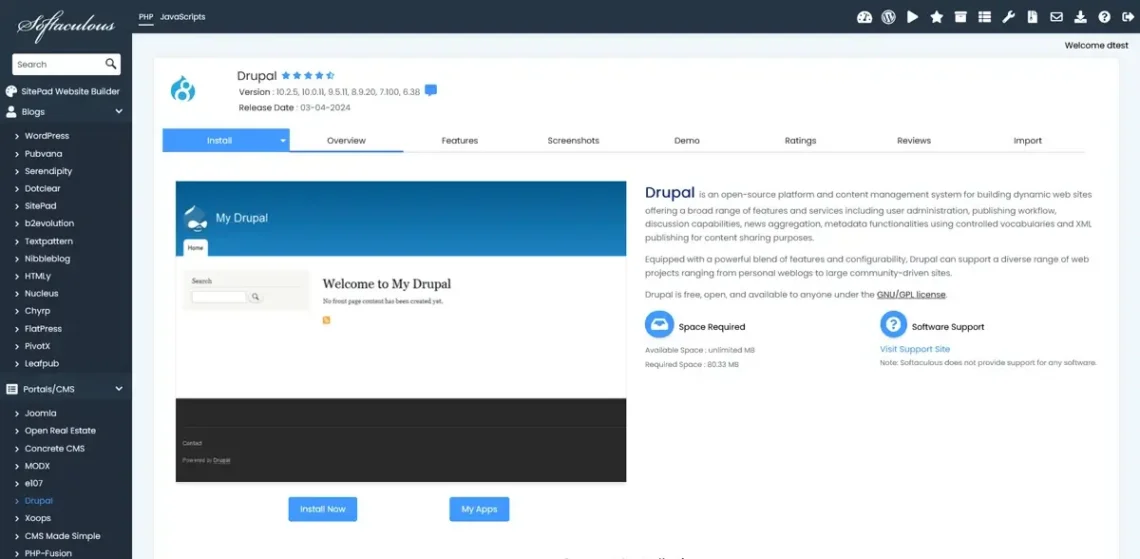
- Add a second domain name.
Your control panel should allow you to add additional domain names. Each new domain has its own document root folder. If you were building a second Drupal site under its own installation, you’d need to specify a different document root for your new domain. However, since you’re building a Multisite setup, you must point it to the same root folder as the primary domain (i.e., the public_html directory).
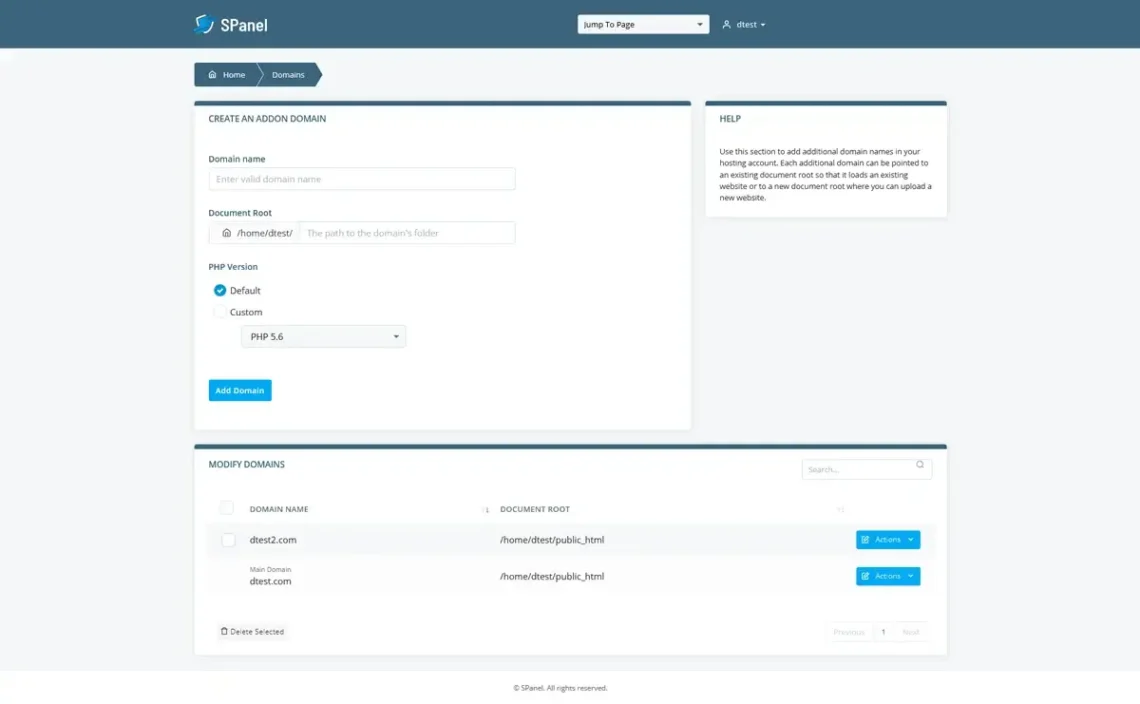
- Edit the sites.php file.
The next step is to tell Drupal we’re building a Multisite installation. To do that, we have to edit one of its configuration files. You can do it through the command line or FTP, but the most straightforward way is to use your control panel’s File Manager.
Navigate to /public_html/sites. You’ll see a file called example.sites.php. It may be a good idea to create a backup copy, just in case. After you do that, rename example.sites.php to sites.php.
You now need to open the sites.php file and enter a line specifying the new domain and the folder where its data will be stored. It should look like this.
$sites[“example.com”] = “example.com”;
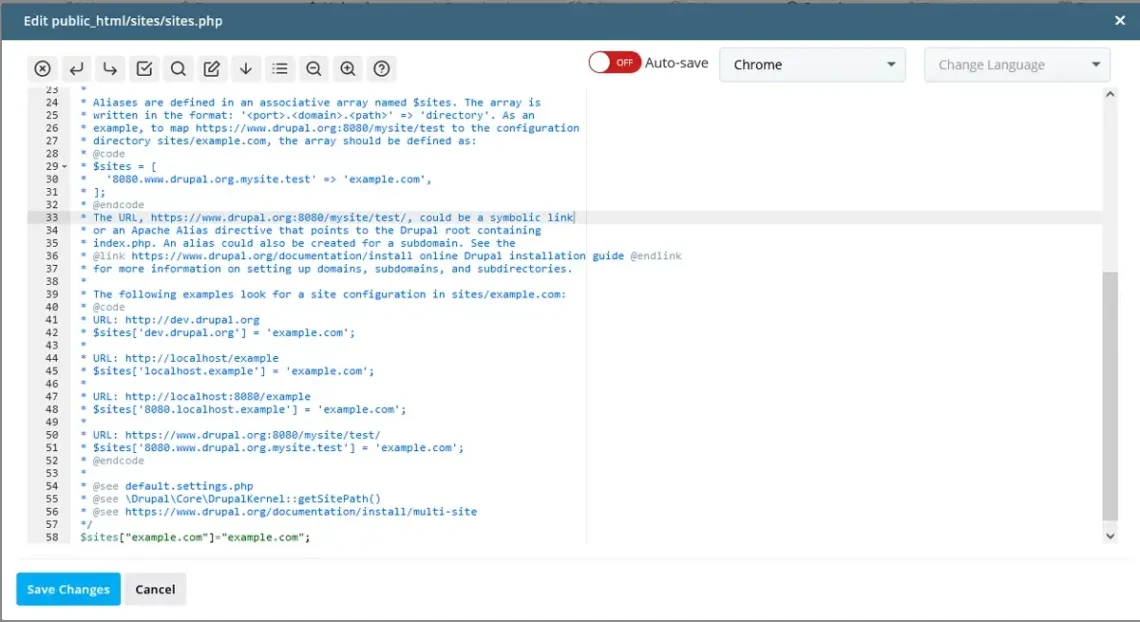
- Create the new domain’s folder and copy the settings.php file.
After you save the sites.php file, you need to create a folder for the new domain inside public_html/sites. The name of the new website folder must be the one you specified in the sites.php file. In our case, it will be called example.com.
Don’t open it just yet. Instead, go to the default directory.

Inside it, you’ll find two files called default.settings.php and services.yml. Copy and paste them into the new domain folder you created a minute ago. Finally, rename default.settings.php to settings.php.
- Create a database for the new site.
More often than not, creating a database for each site on your Multisite installation is the better call. You can set it up through the command line or use a tool like phpMyAdmin. However, your control panel most likely has a database management facility that is much easier to use
In SPanel, ScalaHosting’s proprietary server management solution, it looks like this.
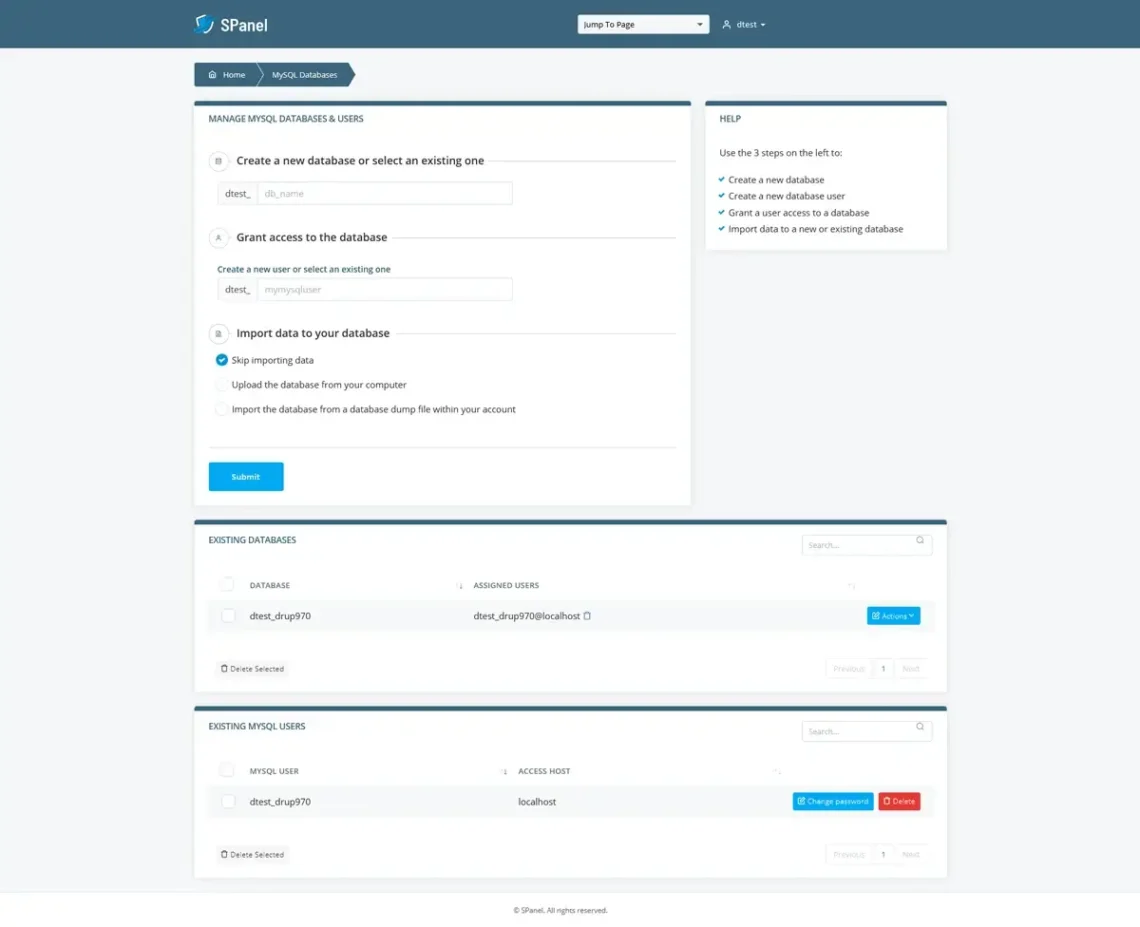
Alongside the new database, you can also create a new MySQL user account. Make sure you memorize its login credentials, as you’ll need them later.
- Follow the installation wizard.
If you load the new domain into your browser now, you’ll see an installation wizard similar to the one you’d see if you were setting up Drupal manually. The steps are pretty straightforward and shouldn’t be a problem, even for the less experienced.

The system will ask you for the database name and the MySQL user account you configured a few steps back. You’ll need to specify things like the site title and need to create a new administrator account. With it, you can log in to the new back end and start managing the project.
To add another website to your Drupal Multisite setup, repeat steps 3-7.
Conclusion
Drupal Multisite is an exciting feature that allows you to host multiple similar websites under the same core platform, applying changes and updates in bulk. Because of its versatility, Drupal will allow you to create a wide variety of projects and its open-source nature makes it very susceptible to customizations.
Choosing a reliable web hosting provider will allow you to take full advantage of the platform and its add-ons, combining a robust environment with timely support.
Contact ScalaHosting today to see how we can help you with Drupal Multisite.


FAQ
Q: What is Drupal Multisite?
A: Drupal Multisite is a feature that lets you develop and run multiple Drupal websites under a single codebase. The sites appear to run independently to users, but they’re connected to the same Drupal installation, which helps you manage them more efficiently.
Q: What is the difference between Drupal Multisite and a standard Drupal installation?
A: If you run your websites under a Multisite installation, you have a single Drupal core supporting all of them. The benefit of this revolves mostly around cost saving and easier management, which means that it’s perfect for organizations that need to run many similar projects at once.
Q: What is the difference between WordPress Multisite and Drupal Multisite?
A: People may draw parallels between Drupal Multisite and the eponymous feature found in WordPress. However, the two serve different purposes. While WordPress Multisite lets you create a network of websites that are connected to each other, Drupal Multisite is all about streamlining the management of multiple projects at once.

